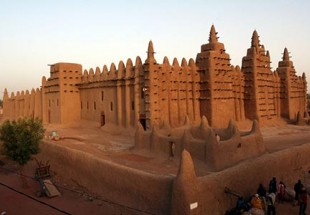Timbuktu; A Historical Islamic City In Africa

 Timbuktu is a historical Islamic city in the modern Republic of Mali. It is approximately 20 kilometers north of River Niger.
Timbuktu is a historical Islamic city in the modern Republic of Mali. It is approximately 20 kilometers north of River Niger.
The roots of Timbuktu is not closely known. Local tradition and indigenous chronicle was written in the 17th century namely, Tarikhes Soudan, which was a nomad group spanning 1100. It soon became a center of Moslem learning.
The southern Saharan caravan route became famous throughout Europe as a market place of slaves and gold.
The Center Tarikhes Soudan was well maintained by slave groups, and old women, the Buktu.
Tin Buktu meanings in the literary sense, “the place of Buktu.” Camps were set seasonally which changed into more permanent settlements owing to the town’s placement at “junction of riverine” and land transportation paths. Discovery is yet to be confirmed in archaeology findings.
After the foundation of Timbuktu, trade centers became scattered all around the region.
The city was under the control of the Mali Empire between the period of 1325-1433, periods in which there appeared to be significant changes in the region.
Occupation of Timbuktu
Cases we will discuss later, Moroccans also invaded Timbuktu in 1591, and the French seized the area by 1893 because of an important trading commodity at the time, salt.
During the Mali reign, there was increased prosperity and political stability. Governments were structured in a well-organized fashion giving rise to good trading benefits. Monumental buildings were raised.
Sankore and Djinguereber mosques (1327) were built, and this structure still stand today. All these were built during the 14th century.
When the empire of Mali collapsed, Timbuktu fell under nomadic Berber control for a period of 32 years, between 1433 and 1468 and the economic prosperity of the great city declined.
The process was exacerbated by the capture of the city by the Sonni Ali, head of Songhai in 1468. The city became incorporated with the Songhay Empire. Historical sources say there was bloodshed in the conquest.
Sonni Ali passed away in 1492 following an unsuccessful reign by his son. After the short and untimely reign of Sonni Ali’s son, Timbuktu became controlled by a new dynasty of Songhay namely the Askias.
At this point, a golden age was reached and trades and scholarship prospered within the city.
The Askias were Muslims, and Timbuktu acquired Islamic learning in Sub-Saharan Africa.
The Koran, Hadith, Islamic sciences and Sharia were studied and taught in universities of various institutions of learning for adults and children alike.
Sankore mosque became the central declarer of Koranic injunctions and trade flourished. Gold and ivory were traded for items such as ceramics, textiles and beads.
The story of excess trade that moved northward excited the Moroccans to the north.
Therefore, in 1590, an army was assembled under the leadership of Judar Pasha, a military general, and following a walk across the desert, the forces defeated the Songhay armies at the battle of Tondibi in 1591.
At that point on, the Moroccans took over the city. Many leading Moslem scholars became exiled from the land.
The Moroccan garrison in Timbuktu was left to its own devices, with a living legacy of their presence being the Arma, a Songhai group who claim Moroccan descent.
The conquest was severe to the Moroccans leading them to end an oppressive administration in 1618.
After 1618 to the early 19th century, Timbuktu came into a period of quietness, having insignificant role in the historically perspective.
Though it seem from an intellectual and economic stand point that the city was unprogressive, Europeans still viewed the city as a land of opportunity.
Various missions were sent to Timbuktu in an attempt to win the city over. Notable individuals such as Robert Adams, Mungo Park attempted to go into the city.
However, it was in August 1826, that an European Major named, Alexander Gordon Laing succeeded. Although he became murdered.
A more fortunate or perhaps lucky traveler was Frenchman Rene Caillie, who arrived in Timbuktu in 1828 pretending to be an Arab by dressing like one.
Caillie became somewhat disappointed in his travel since the tale of the city did not seem to match his sight of it. He found it dull and indolent.
After that did many European adventurers traveled to view the city, in their travel—they provided information about the trade, markets, mosques, peoples and products manufactured in Timbuktu.
After the documentations by the French, such information provided helped the French army devise means of conquering the land and making it fall into European powers.
The French troops reached the city in December 1893, but some of them became killed by the Tuaregs. The occupation became achievable the following year causing the colonial reign of Timbuktu to last for sixty years.
After sixty years of reign, Timbuktu gained independence and a new nation of Mali was formed in 1960.
Since that time, Timbuktu has continued to function as the center power administrator and trade route serving both the nomadic and sedentary population of the area.
Tourism has also increased, with Europeans and Americans visiting structural sites as documented in their text at home.







